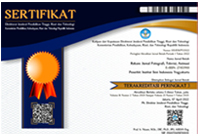Bodies on Social Phenomena: Implementation of Cyanotype Photogram-Based Creation and Oil Paint
Abstract
The goal of this research is to create an artwork by combining two genres of art, specifically photography and painting. The primary foundation of this composition is Cyanotype, or photograms on Cyanotype media, a 19th-century photographic process. Exploration and experimenting on the technique and concept of the piece are the primary methods used in this creation. The end result is a collaborative work using Cyanotype and painting technique to enhance the character and concept of the piece. This type of collaborative creativity is still uncommon, and it is critical to adopt it as a new way of working. Cyanotype is an old photography method that is still used today. These conditions encourage exploration. The combination of cyanotype and painting techniques allows for the development of more unique and valuable works. The body in social phenomena is the focus of this collaborative effort. The findings of this study support Langer's idea that art is an expressive form formed by perception through the senses or imagination and conveyed from human feelings. Physical feelings, pain, comfort, and joy are all examples of this type of expression.
Penelitian terapan ini merupakan upaya penciptaan karya melalui kombinasi dua bidang seni, yaitu seni fotografi dan seni lukis. Pondasi dasar penciptaan ini adalah teknik fotografi abad ke-19 yaitu Cyanotype, tepatnya fotogram di atas media Cyanotype. Metode utama dalam penciptaan ini adalah eksplorasi dan eksperimentasi terhadap teknik dan tema karya. Hasil awal berupa cetakan Cyanotype dikombinasikan dengan torehan cat lukis untuk memperkuat karakter dan tema karya. Penciptaan kolaboratif semacam ini masih sangat jarang dilakukan dan penting untuk menjadi cara baru dalam berkarya. Cyanotype sendiri adalah teknik fotografi tua yang dibuat secara ‘handmade’. Kondisi tersebut membuka ruang eksperimentasi. Pengombinasian Cyanotype dan teknik lukis membuka peluang terwujudnya karya yang unik dan bernilai lebih. Tema yang diangkat dalam karya kolaboratif ini adalah tubuh dalam fenomena sosial. Hasil penelitian ini sesuai dengan teori Langer, bahwa karya seni merupakan bentuk ekspresif yang diciptakan menurut persepsi melalui indera atau imajinasi yang diekspresikan dari perasaan manusia. Bentuk ekspresi ini adalah segala sesuatu yang dapat dirasakan, sensasi fisik, rasa sakit, kenyamanan, dan kegembiraan. Tubuh manusia digambarkan sebagai objek utama karena manusia merupakan pemain kunci dalam mengelola alam di bumi ini. Perpaduan proses Cyanotype dan seni lukis memiliki ciri yang berbeda, terutama ekspresif, spontan, dan dinamis yang menggambarkan kesedihan dan ketakutan.
Keywords
Full Text:
PDFReferences
Chilvers, I. (1990). The Concise Oxford Dictionary of Art and Artists. In I. Chilvers (Ed.), Choice Reviews Online (Vol. 41, Issue 07). Oxford and New York: Oxford University Press. https://doi.org/10.5860/choice.41-3774
Darmawan, Y. S., & Wikayanto, A. (2018). Tren Kamera Analog Instan di Kalangan Remaja Indonesia. REKAM: Jurnal Fotografi, Televisi, Dan Animasi, 14(2), 97–106. http://www.javafoodie.co/2010/08,
Faturahman, W. (2022). Analisis Karya Fotografi Pieter Hugo “Rwanda #14 .” REKAM: Jurnal Fotografi, Televisi, Dan Animasi, 18(2), 145–150. https://doi.org/https://doi.org/10.24821/rekam.v18i2.7700
Jungles, A. (2019). Beyond the Blue : Cyanotype ’s Qualities of Light , Time , and Space. College of Saint Benedict and Saint John’s University.
Karpov, D., & Kryuchkov, Y. (2015). Analytical Photography as a New Tool for the Representations of Reality. Procedia - Social and Behavioral Sciences, 166, 675–679. https://doi.org/10.1016/j.sbspro.2014.12.595
Kuncorojati, W. (2019, September). Our Final Pose, Karya dengan Teknik Abad XIX di Pameran Abad Fotografi. Seni & Budaya Gudeg.Net.
Langer, S. K. (1957). Problems of Art. In New Scholasticism (Vol. 32, Issue 4, pp. 518–523). Charles Scribners Sons, New York. https://doi.org/10.5840/newscholas195832478
Ocvirk, O. G., Stinson, R. E., Wigg, P. R., Bone, R. O., & Cayton, D. L. (2013). Art Fundamentals Theory and Practice (12th ed.). Mc-Graw Hill.
Önen, N. (2019). “Fauxssilles” for the Future: Cyanotype Expressions on Plastic Waste. USA: SEQUITUR, Volume 6, Issue 1 (Fall), 6(June), 1–7.
Rusli, E. (2018). Citra Dan Tanda Malioboro Dalam Konstruksi Fotografi. REKAM: Jurnal Fotografi, Televisi, Dan Animasi, ISI Yogyakarta, 14(1), 1. https://doi.org/10.24821/rekam.v14i1.2133
Setiyanto, P. W., Andrea, N. J., & Triyana, A. (2022). Iconography and Iconology of The Aksi Kamisan Photo (13-2- 2014 ) by Fanny Octavianus. Journal of Urban Society’s Arts, 9(April 2022), 25–33. https://doi.org/https://doi.org/10.24821/jousa.v9i1.6017
Susanto, A. A. (2017). Fotografi adalah Seni: Sanggahan terhadap Analisis Roger Scruton mengenai Keabsahan Nilai Seni dari Sebuah Foto. Journal of Urban Society’s Arts, 4(1), 49–60. https://doi.org/10.24821/jousa.v4i1.1484
Wallas, G. (2015). The Art of Thought. Solis Press.
Yogyakarta, I. (2022). Katalog Sudah Ingat, Alternative Photographic Processes Exhibition APHIC WEEK#2. Yogyakarta, ISI.
DOI: https://doi.org/10.24821/rekam.v19i1.9436
Refbacks
- There are currently no refbacks.

This work is licensed under a Creative Commons Attribution 4.0 International License.



